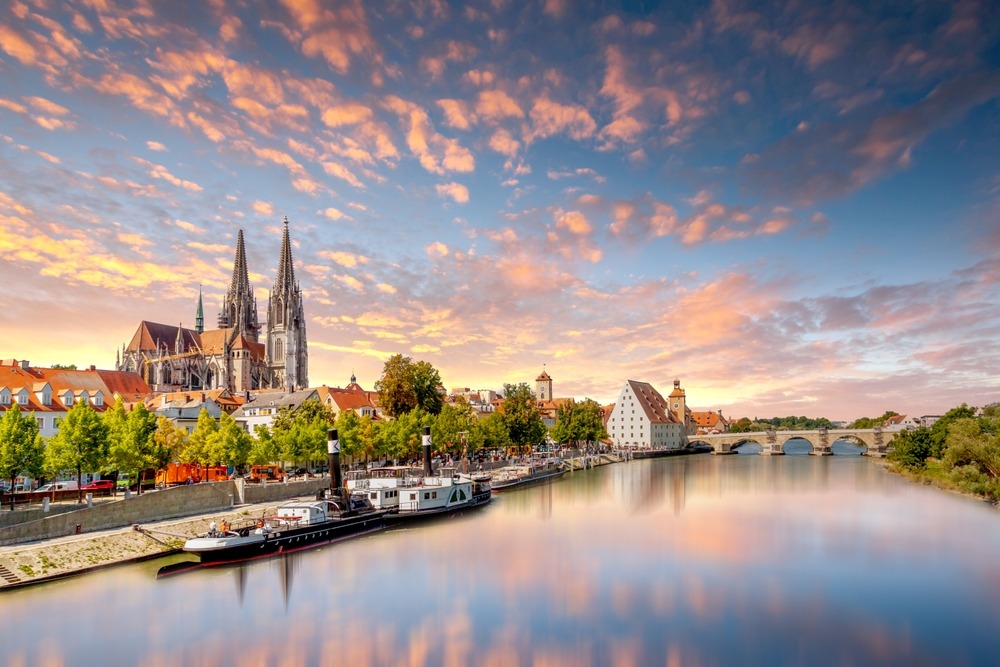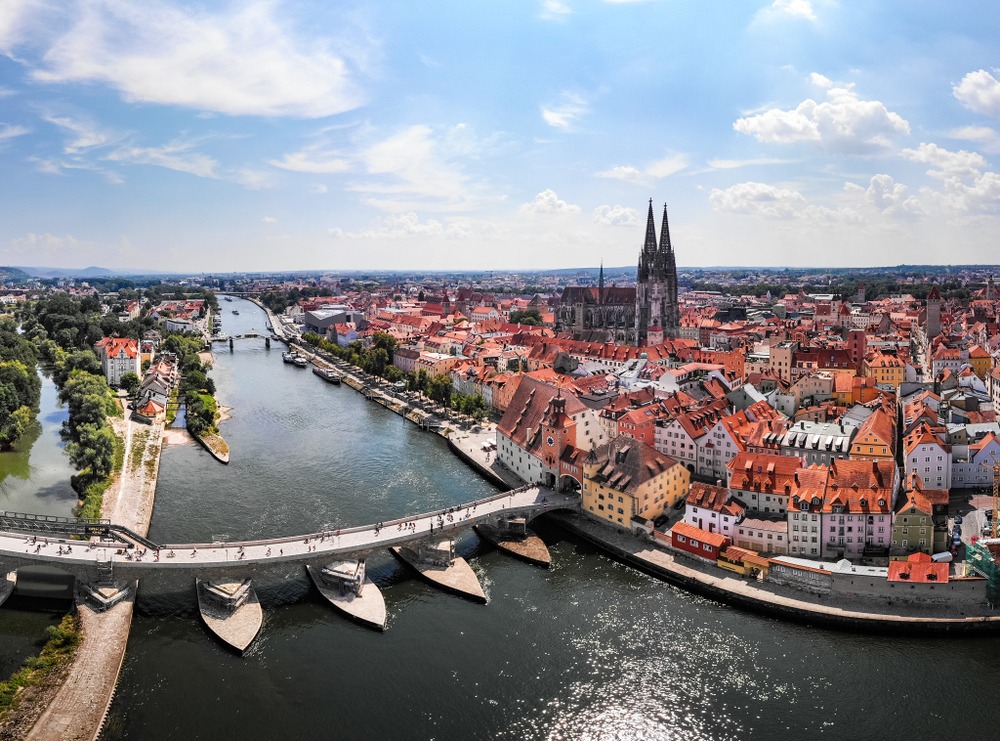Regensburg, Germany: A Journey Through Time and 25 Unmissable Attractions
History of Regensburg, Germany
Regensburg, one of Germany’s oldest cities, is a cultural and historical gem situated at the meeting of the Danube, Naab, and Regen rivers. Its roots stretch back to the days of the Celts, but its documented history begins with the Roman Empire. In 179 AD, Roman Emperor Marcus Aurelius established the fortress of Castra Regina, meaning “fortress by the Regen,” forming the backbone of what would become modern Regensburg. Remnants of the Roman wall can still be seen today, offering a tangible link to its imperial past.

During the early Middle Ages, Regensburg became a vital political and ecclesiastical hub. It served as the seat of the Bavarian dukes and later the capital of the Duchy of Bavaria. By the 11th and 12th centuries, the city flourished as a center for trade, thanks to its strategic location along the Danube River. Merchants from across Europe and even Byzantium and the Islamic world passed through Regensburg, helping it amass considerable wealth and architectural splendor.
Its medieval skyline of spires, towers, and gabled roofs is largely intact, preserving a rare and authentic view into the urban landscape of a High Middle Ages German city. The construction of the iconic Stone Bridge (Steinerne Brücke) in the 12th century was a testament to Regensburg’s engineering prowess and its role as a critical trade artery between northern Europe and the Mediterranean.
Religious institutions such as St. Emmeram’s Abbey and Regensburg Cathedral (Dom St. Peter) made the city a key ecclesiastical center. In the 16th century, Regensburg became a stronghold of the Protestant Reformation, although it retained a significant Catholic presence.
In 1663, Regensburg became the permanent seat of the Imperial Diet (Reichstag) of the Holy Roman Empire, anchoring it as a center of political influence until the empire’s dissolution in 1806. The city escaped significant destruction in World War II, allowing it to retain much of its historic architecture.
Today, Regensburg is a UNESCO World Heritage Site, celebrated for its well-preserved medieval core, vibrant cultural life, and enduring connection to the Danube. It blends centuries of architectural evolution with a thriving modern community, making it one of Germany’s most cherished historic cities.

Top 25 Attractions in Regensburg, Germany
-
Regensburg Cathedral (Dom St. Peter) – A Gothic masterpiece with soaring spires and intricate stained glass, this cathedral is the spiritual heart of the city and a marvel of medieval craftsmanship.
-
Stone Bridge (Steinerne Brücke) – Built in the 12th century, this arched stone bridge was a marvel of medieval engineering and offers striking views of the Danube and old town.
-
Old Town Hall (Altes Rathaus) – A complex of Gothic and Baroque buildings that once housed the Imperial Diet, it now features a museum and guided tours of the old torture chamber and council halls.
-
Porta Praetoria – This Roman gate, dating back to 179 AD, is one of the oldest stone structures north of the Alps and a direct link to Regensburg’s Roman origins.
-
St. Emmeram’s Abbey and Palace Thurn und Taxis – Once a powerful Benedictine abbey, this complex now houses the lavish palace of the Thurn und Taxis family, who were instrumental in Europe’s postal history.
-
Goliath House (Goliathhaus) – A striking mural of David and Goliath adorns this 13th-century patrician house, which blends history with modern use.
-
Scots Monastery (Schottenkirche) – A Romanesque church founded by Irish missionaries, known for its distinctive north portal and historical ties to Celtic Christianity.
-
Neupfarrplatz – A square rich in layers of history, from Roman ruins beneath to a former Jewish quarter, now home to memorials and a modern shopping area.
-
Regensburg Museum of History – Located in a former monastery, this museum chronicles the city’s past through artifacts, models, and exhibitions.
-
The Old Chapel (Alte Kapelle) – A richly decorated Rococo church built atop a Roman site, revered for its golden altar and sacred significance.
-
St. Jakob’s Church (Jakobskirche) – Known as the Schottenkirche, this 12th-century Romanesque gem features carved portals and a serene, monastic atmosphere.
-
Bismarckplatz and Theater Regensburg – A cultural hub of modern Regensburg, home to theater performances, concerts, and seasonal festivals.
-
Kepler Memorial House – The former residence of astronomer Johannes Kepler, now a museum dedicated to his scientific legacy.
-
Baumburg Tower (Baumburger Turm) – One of the many medieval towers still dotting Regensburg, showcasing the wealth and status of patrician families.
-
Document Neupfarrplatz Museum – An underground museum offering an immersive look into Roman, medieval Jewish, and modern histories layered beneath the city center.
-
Stadtamhof District – A charming neighborhood just across the Stone Bridge, offering quaint streets, local eateries, and beautiful river views.
-
Regensburg Synagogue Memorial – A somber and reflective site commemorating the history and destruction of the city’s historic Jewish community.
-
Danube Shipping Museum – Housed aboard a historic paddle steamer, this museum explores the history of river transport in the Danube region.
-
Botanical Garden of the University of Regensburg – A tranquil and educational space showcasing native and exotic plant species.
-
Wurstkuchl (Historic Sausage Kitchen) – Reputedly the oldest continuously operating public restaurant in the world, serving bratwurst since the 12th century next to the Stone Bridge.
-
Villapark and Herzogspark – Beautiful green spaces ideal for walking, picnicking, and enjoying riverfront views and seasonal blooms.
-
House of Bavarian History (Haus der Bayerischen Geschichte) – A modern museum focusing on Bavaria’s cultural and political development, recently opened in Regensburg.
-
Donau-Arena – A modern venue for concerts, ice hockey games, and community events, representing the city’s contemporary culture.
-
Wöhrd Island (Inselpark Wöhrd) – A large recreational island in the Danube, perfect for cycling, swimming, and relaxing outdoors.
-
Golf Museum Regensburg – A quirky and specialized museum featuring over 1,200 exhibits chronicling the history of golf from medieval times to the present.

Regensburg captivates visitors not only with its remarkably preserved past but also with its seamless integration of old and new. The city’s cobbled lanes, grand cathedrals, riverside charm, and vibrant cultural scene make it a must-see destination in Bavaria. Whether wandering ancient Roman ruins or sipping coffee in a medieval square, Regensburg offers a journey through time like no other.

































